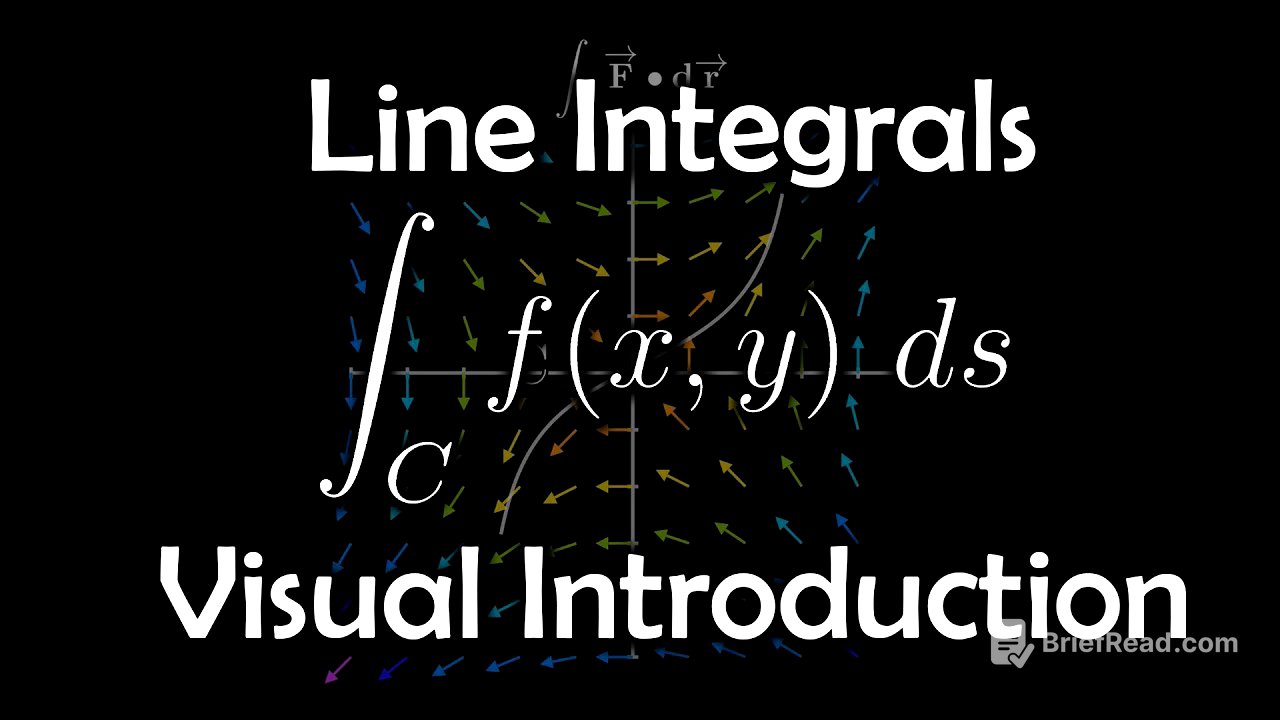TLDR;
This video provides an introduction to line integrals, covering both scalar and vector fields. It begins by explaining scalar fields and arc length, then transitions into line integrals over scalar fields, providing visual intuition and a textbook-style problem. The video then introduces vector fields and explains how to calculate line integrals over them, again with a visual animation and a practice problem.
- Scalar fields are functions that take multiple inputs and return a single output, visualized as a 3D surface.
- Arc length is calculated by summing small hypotenuses along a curve, leading to an integral formula.
- Line integrals over scalar fields involve summing the values of a function along a curve in 3D space.
- Vector fields associate each point in space with a vector, used to describe phenomena like fluid flow and electromagnetic fields.
- Line integrals over vector fields involve taking the dot product of the vector field and the derivative of the curve, integrated over the curve's parameter.
Introduction to Line Integrals [0:02]
The video introduces line integrals as a fundamental concept in multivariable calculus with applications in physics, including work, Ampere's Law, and Faraday's Law. The focus is on providing a visual and intuitive understanding of line integrals, rather than a heavy emphasis on notation and formulas.
Scalar Fields [0:21]
A scalar field is defined as a function that takes multiple inputs and produces a single output. An example is the function f(x,y) = x^2 + y^2, which takes two inputs (x and y) and returns one output. This function can be graphed in 3D space, with the x, y, and z axes representing the inputs and output, respectively. The video encourages viewers to experiment with 3D plotters to visualize different scalar fields.
Arc Length Recap [1:00]
The video reviews the concept of arc length from Calculus 2, starting with a continuous differentiable function f(x). A small step in the x-direction, denoted as delta x, results in a corresponding change in the function, delta y. The hypotenuse of the resulting triangle, delta s, is calculated using the Pythagorean theorem: delta s = sqrt(delta x^2 + delta y^2). The arc length is then approximated by summing all these small hypotenuses. To find the exact arc length, the limit as the changes approach zero is taken, resulting in an integral. This integral is commonly written as the integral from a to b of ds, where ds = sqrt((dx/dt)^2 + (dy/dt)^2) dt.
Line Integrals Over a Scalar Field [2:12]
Line integrals over a scalar field involve a curve C and a surface F. The curve C is defined as a 2D parametric equation, and F is a 3D surface. The line integral is the sum of all the values of F along the curve C. Visually, this involves laying the curve C on top of the 3D surface F and summing the values of F at each point on C. This can be represented as a definite integral, where the parametric equation is plugged into F, and ds is expanded to account for the curve's path.
Textbook Problem: Scalar Field [3:58]
The video presents a textbook-style problem to demonstrate the calculation of a line integral over a scalar field. First, the curve C is graphed and then parametrized. The derivatives dx/dt and dy/dt are found, and ds is calculated using the formula derived earlier. Finally, the line integral is evaluated by plugging the parametric equations and ds into the integral and computing the result.
Vector Fields [5:00]
A vector field associates every point in space with a vector. For example, the vector field F = <x, y> assigns a vector to each point (x, y) in the plane. Vector fields are used to describe various phenomena, such as fluid flow, electric fields, magnetic fields, and gravitational fields. The video provides links to resources for visualizing vector fields and calculating their divergence and curl.
Line Integrals Over Vector Fields [5:46]
To calculate the line integral of a vector field, the dot product of the vector field F evaluated at the curve r(t) and the derivative of the curve r'(t) is taken, and then integrated over the interval [a, b]. The dot product gives a value that indicates how aligned the two vectors are. The integral represents the accumulation of this alignment along the curve.
Textbook Problem: Vector Field [7:33]
The video presents a textbook problem for calculating the line integral over a vector field. The curve C is graphed and parametrized. Then, F(r(t)) and r'(t) are found. Using the formula, the integral is set up and evaluated to find the result.
Conclusion [8:18]
The video concludes by summarizing the introduction to line integrals and mentioning that there is more to cover, such as the fundamental theorem of line integrals and Green's Theorem, suggesting a potential part 2.









